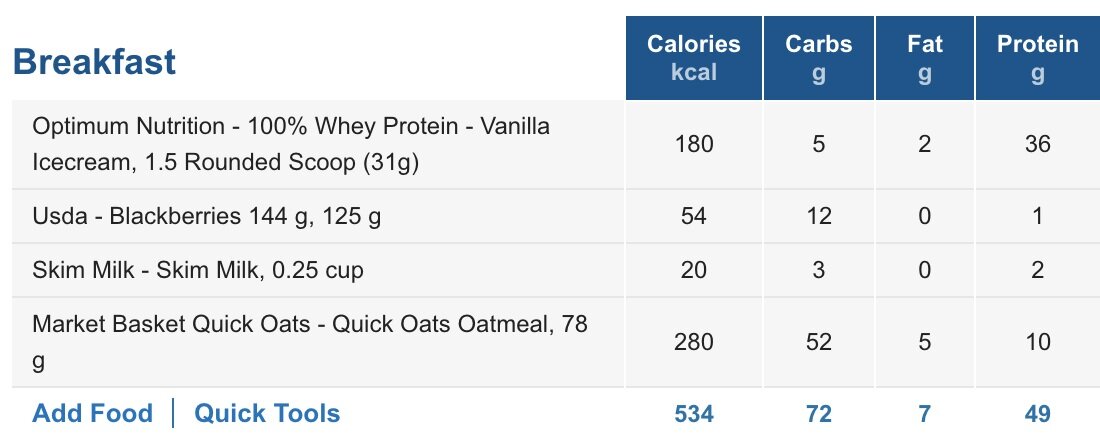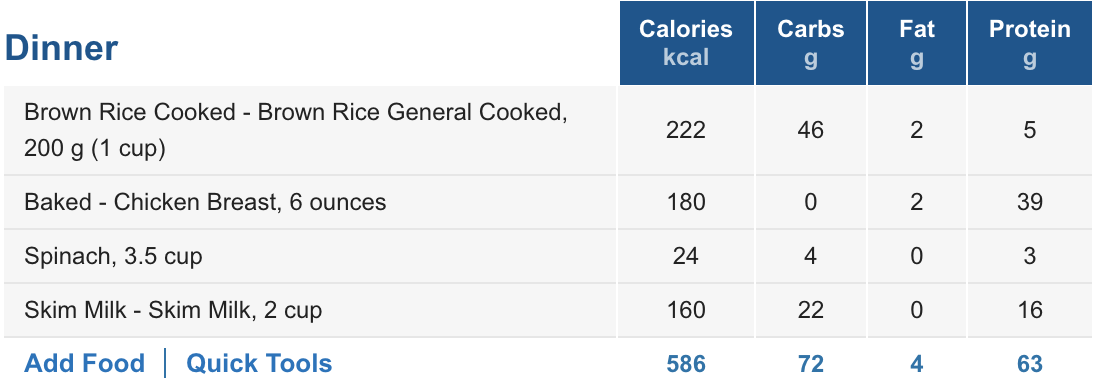It’s a big question in the fitness space: Intuitive eating or counting macros? Which approach is really better for helping you achieve you body composition goals? Let’s set the scene.
For the purposes of this write-up, I’ll be using the phrase “intuitive eating" exclusively in context of those who are implementing it as a strategy for systematic fat loss or muscle gain, which means I’m not talking about it for anyone who is simply looking for a dietary approach that "works for them.” On the other hand, the second term I’ll be considering in-depth is a dietary approach commonly known as the “If It Fits Your Macros” movement (IIFYM), which favors a less intuitive and more calculated methodology to physique improvement that involves eating a certain amount of proteins, carbohydrates, and fats per day within a given caloric window. Another apparent perk of IIFYM? You can eat “whatever you want” (even the “unhealthy foods”) to hit those macronutrient targets. But, there are pros and cons of both.
Let’s break it down even a bit further.
DEFINING THE TERMS
Intuitive eating, as I see it, is a culture of eating that says, “Eat what you want and when you want according to your hunger cues.” Simply put, eat when you’re hungry and stop when you’re satisfied. It seems simple and to the point, and it is.
Counting your macros, however, urges its users to eat within a certain caloric and macronutrient range on a daily or weekly basis with little to no consideration of hunger cues or any natural inclination of when to eat.
Are you starting to see the trend? As their names suggest, one promotes fluidity while the other favors systematic calculation.
As the title suggests, however, intuitive eating (at least for the time being) has certainly stolen the cultural spotlight for many people - and for good reason. If you think about it, the idea really is quite sexy. It’s natural and seemingly casual. It’s loose and fluid - carefree and maybe even a bit rebellious.
Now, since this is a hot take, I’m probably going to reveal some bias in this write-up, but that doesn’t mean I’m saying one is inherently better than the other, nor does it mean I think you should or shouldn’t do one or the other. That choice is 100% up to you. These are just my thoughts and opinions, and I want to make that very clear throughout.
In thinking about this, I’ve developed an analogy called the “Jacked Guy In a Grocery Store” analogy.
MY “JACKED GUY IN A GROCERY STORE” ANALOGY
Imagine walking through the grocery store and noticing a man in his early 30’s with a phenomenally fit and attractive shape. Being a curious kitten, you muster the courage to ask him “what his secret is,” and he responds with something like this: “I just listen to my body actually. If I’m hungry, I eat. And I always stop when I’m satiated. It works great for me and it keeps me looking the way I want to.”
Sexy, right? You’d be instantly drawn to the effortlessness in his voice, and the mystery of its simplicity would be fascinating.
Now, imagine the exact same scenario, but he offers you this response instead: “I’m actually really meticulous about the amount of calories I consume, and I tailor them according to my current goals. I eat between 3-5 meals a day, and I always design my meals around a high-quality protein source supplemented with a vegetable and a carb source like potatoes or rice since I workout quite a bit. If I’m trying to build muscle I eat a bit more and when I’m trying to trim up I reduce my portion sizes. But generally I eat the same whole foods and try to minimize the junk. Oh, and I eat plenty of fruits and veggies.”
And you think in your head something like this, “Well, that actually makes a lot of sense.” Why?
Because his answer was boring. I’d even be willing to bet you’d be a bit disappointed. No secret remedy? Just an honest application of a bunch of stuff that makes pretty good logical sense?
However, I’m not saying that the guy in our first scenario is a complete unicorn. For those with favorable genetics for physique development, it’s quite possible to look really good while putting little thought into your diet. In fact, those people are all over Instagram. As I’ve heard it said many times, plenty of people look amazing in spite of their poor practices. They are the genetically “blessed” - the ones who can “get away with it.
But this is certainly not the norm, and it’s certainly not a plausible reality for too many people who are just embarking on their fitness journeys - especially if you’re setting sail because you’re currently 30 pounds overweight. After all, if you were already genetically blessed, would you really be asking people in the grocery store for their secret remedy? Probably not. You’d have a remedy of your own with little interest in what happened to be working for someone else.
Having said that, let’s get into the practical applications.
I THINK MOST OF US ARE HOLDING OUT FOR A QUICK-FIX SOLUTION.
In the online coaching space, hundreds and thousands of people are finding coaches online, engaging with them, and hiring them to help them achieve their body composition goals. It’s also worth mentioning that there are plenty of people out there who, despite not being able to afford an online coach, are doing their best to implement the “right kind” of diet and exercise to either drop body fat or muscle-up for beach season. So in this case we’re considering two major populations of people placing a value of either money, time, or other resources into their body composition: the people who have already hired coaches and those who are basically trying to coach themselves to save a buck.
And yet one thing I have found to be the case with many of these people when they talk to me about “losing weight” or “getting jacked” is that they just don’t want to track their calories or count their macros. In fact, as soon as I tell people I track my macros, I can almost always sense an immediate and unmistakable disinterest in continuing the conversation. Why? Because I don’t have the secret remedy they’ve been searching for. There’s nothing sexy about tracking your macros to achieve your physique goals just like there’s nothing sexy about a university student studying for weeks on end to pass their chemistry exam.
If I heard that my friend had passed his final with flying colors and asked him how he did it, what do you imagine he would say? He’d probably tell you that he attended class attentively, took detailed notes, compiled a study guide, and then studied those materials meticulously. And in that case, what sense would it make for me to be - dare I say - disappointed in that answer? None at all! In fact, I doubt anyone would be naive enough to offer any other answer but just some good and honest hard work.
But just for fun, let’s talk about what many of us would rather hear him say. “Oh, I just went to class when I felt like it, took notes when I felt like it, and studied when I felt like it. And it was awesome. It all just kind of happened casually and I got an A. Actually, now that I think about it, I don’t think I ever took notes.” (insert casual chuckle)
In my experience, a lot of people only get interested when they become convinced that getting the physique of their dreams is easily achievable. And let’s be honest, eating intuitively will always be easier than counting your macronutrient intake, which is why I think people are so eager to kick a more meticulous approach to the curb.
Now, here’s where things might get a little spicy.
I have to admit that I get a bit miffed when people seem to want to achieve a physique goal without counting their macros, and here’s why: For a lot of people, intuitive eating is exactly what led them to hire a body composition coach in the first place. And, to be fair, if your intuitive eating had actually been working well for you up until this point, we’d probably be discussing something like sports or the weather instead of your muffin top right now. Yikes! Maybe that stings, but I can’t help but be honest in thinking that’s the truth of it.
At the very same time, there’s absolutely nothing wrong with having a muffin top. I have personally had a muffin top of my own in certain seasons of life.
Maybe your significant other adores your muffin top and you feel like a king among men accentuating your waistline accomplishment. Good on you! I really say that without sarcasm because I never want to pretend like we all have to have the same idea of what’s attractive or desirable in terms of body shape. If you are healthy and feeling amazing in your own body, press on.
Do you see my bigger point though? How silly is it to approach a coach while 20-30+ pounds overweight and insist on an approach that continues to allow you to eat intuitively?
In some sense I’d even be tempted to tell someone that they’ve "lost their privilege" of eating intuitively, but that really makes you sound like a super villain. You had a good thing (intuitive eating) and it became a bad thing (overeating to the point of unhealthy weight gain), and now we’re going to try a different thing if (and that’s a big if) you’re telling me you have serious goals about changing your body shape.
It's kind of like an sixteen year-old kid being given a cool sports car from his parents just because they wanted to gift him something special for being their son. But sooner than later he starts breaking curfew because he’s out drinking booze and smooching on Sally Sue on the weekends, and his grades start to suffer. At the end of the semester he’s sitting on a report card of two F’s, a D+, and an A+ for irresponsibility. The car gets yanked and mom starts driving him around again until he’s proven he can correct his behavior.






















